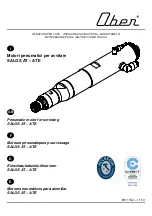
±
HELPFUL TIPS & SUGGESTIONS
STORING YOUR ENGINE
Storage Preparation
Cleaning
Fuel
Inspection
AIR VENT TUBE
IDLE SPEED
Adjustment
Adding a Gasoline Stabilizer to Extend Fuel Storage Life
ENGLISH
RETAINERS
AIR VENT TUBE
THROTTLE STOP SCREW
9
Proper storage preparation is essential for keeping your engine
trouble-free and looking good. The following steps will help to
keep rust and corrosion from impairing your engine’s function and
appearance, and will make the engine easier to start when you use
it again.
If the engine has been running, allow it to cool for at least half an
hour before cleaning. Clean all exterior surfaces, touch up any
damaged paint, and coat other areas that may rust with a light film
of oil.
Using a garden hose or pressure washing equipment can force
water into the air cleaner or muffler opening. Water in the air
cleaner will soak the air filter, and water that passes through the
air filter or muffler can enter the cylinder, causing damage.
Check that the air vent tube is
secured by the tube retainers
without collapsing or kinking.
Start the engine outdoors,
and allow it to warm up to
operating temperature.
Standard idle speed:
With the engine idling, turn
the throttle stop screw to
obtain the standard idle
speed.
Depending on the region where you operate your equipment, fuel
formulations may deteriorate and oxidize rapidly. Fuel
deterioration and oxidation can occur in as little as 30 days and
may cause damage to the carburetor and/or fuel system. Please
check with your servicing dealer for local storage
recommendations.
Gasoline will oxidize and deteriorate in storage. Deteriorated
gasoline will cause hard starting, and it leaves gum deposits that
clog the fuel system. If the gasoline in your engine deteriorates
during storage, you may need to have the carburetor and other
fuel system components serviced or replaced.
The length of time that gasoline can be left in your fuel tank and
carburetor without causing functional problems will vary with
such factors as gasoline blend, your storage temperatures, and
whether the fuel tank is partially or completely filled. The air in a
partially filled fuel tank promotes fuel deterioration. Very warm
storage temperatures accelerate fuel deterioration. Fuel
deterioration problems may occur within a few months, or even
less if the gasoline was not fresh when you filled the fuel tank.
Fuel system damage or engine performance problems resulting
from neglected storage preparation are not covered under the
Distributor’s Limited Warranty.
You can extend fuel storage life by adding a gasoline stabilizer
that is formulated for that purpose, or you can avoid fuel
deterioration problems by draining the fuel tank and carburetor.
When adding a gasoline stabilizer, fill the fuel tank with fresh
gasoline. If only partially filled, air in the tank will promote fuel
deterioration during storage. If you keep a container of gasoline
for refueling, be sure that it contains only fresh gasoline.
Add gasoline stabilizer following the manufacturer’s instructions.
After adding a gasoline stabilizer, run the engine outdoors for 10
minutes to be sure that treated gasoline has replaced the
untreated gasoline in the carburetor.
Stop the engine.
1.
2.
1.
2.
3.
1,500
150 rpm
09/07/06 19:01:24 32Z4F810_009
Summary of Contents for 160
Page 15: ...09 07 06 19 03 41 32Z4F810_015 ...










































